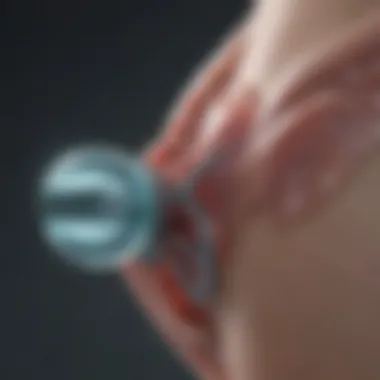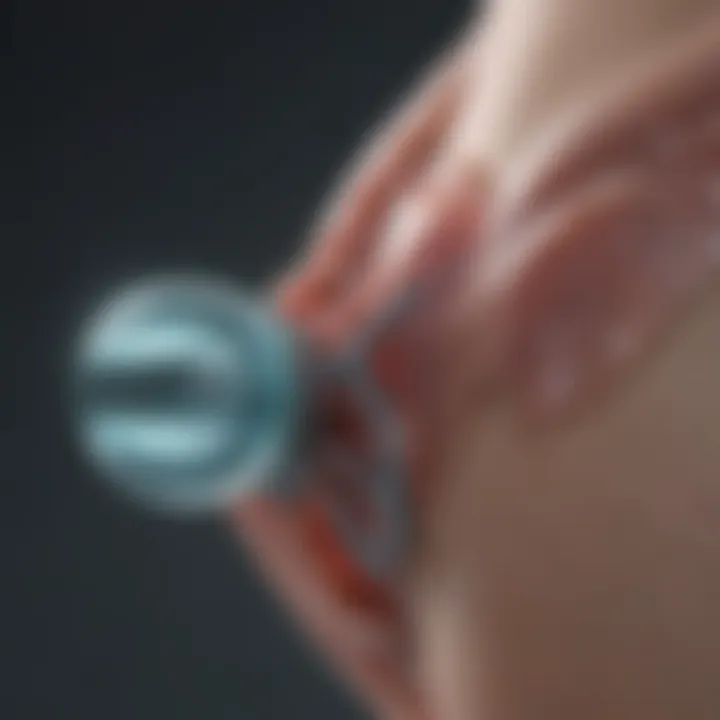Intrauterine Device Types: A Comprehensive Analysis


Intro
Understanding intrauterine devices, commonly known as IUDs, is crucial for anyone interested in modern contraceptive methods. IUDs provide a reliable option for family planning and can serve various medical purposes beyond contraception. In recent years, the discussion surrounding IUDs has become more prevalent, highlighting their effectiveness and the importance of selecting the right type.
The aim of this article is to provide a detailed examination of the different types of IUDs available. By exploring both hormonal and non-hormonal options, the article intends to inform a broad audience, including healthcare professionals and potential users of these devices. In the following sections, we will delve into the mechanisms of action for each type, their individual benefits and risks, and the factors contributing to an informed choice in IUD selection.
We will also investigate leading brands of IUDs, along with clinical data that reflects their efficacy in real-world applications. Through this comprehensive narrative, readers will gain a clearer picture of how these devices function within the sphere of reproductive health.
Foreword to Intrauterine Devices
Intrauterine devices, commonly known as IUDs, serve a significant role in modern reproductive health. Their importance lies in their effectiveness as a long-term contraceptive option, which is essential for many people seeking reliable family planning solutions. This section aims to elaborate on the fundamental aspects of IUDs, highlighting their mechanisms, advantages, and considerations that warrant attention from healthcare professionals and potential users alike.
What is an Intrauterine Device?
An intrauterine device is a small, T-shaped contraceptive device that is placed inside the uterus. The primary function of the IUD is to prevent pregnancy. There are two main types: hormonal IUDs, which release hormones to inhibit ovulation and modify the uterine lining, and copper IUDs, which use copper to create an environment that is toxic to sperm. The presence of the IUD alters the uterus environment, making it less favorable for sperm to fertilize an egg. This leads to a high efficacy rate in preventing unintended pregnancies, with some IUDs being effective for up to ten years.
History and Evolution of IUDs
The inception of IUDs dates back to the early 20th century. Initially developed for animal use, the modern IUD emerged in the 1960s. Early designs were made from various materials, but the introduction of the copper and hormonal IUDs marked a pivotal moment in contraceptive technology. The progression from the Dalkon Shield, which faced significant backlash due to safety issues, to the current safer and more effective models demonstrates the evolution of IUDs. Today, innovations continue to arise, leading to enhanced user experiences and expanded functionalities. Understanding this history is vital, as it contextualizes current clinical recommendations and the advancements that improve the safety and efficacy of intrauterine devices.
Types of Intrauterine Devices
Understanding the various types of intrauterine devices (IUDs) is crucial for informed decision-making regarding contraceptive methods. The choice between hormonal and copper IUDs can greatly affect not only the efficiency of contraception but also the overall health outcomes and personal experiences of the users. Each type presents unique characteristics, advantages, and drawbacks that warrant a detailed analysis.
Hormonal IUDs
Hormonal IUDs are a popular form of long-acting reversible contraception. They release hormones, particularly progestin, into the uterus. This hormone alters the uterine lining and thickens cervical mucus, thereby preventing sperm from fertilizing an egg.
Mechanism of Action
The mechanism of action of hormonal IUDs is primarily centered around the localized release of hormones. Progestin prevents ovulation in many cases, which is a significant feature for those seeking high efficacy. The key characteristic of this mechanism is that it not only provides contraceptive benefits but can also lead to lighter menstrual bleeding or even amenorrhea in some users. This dual function makes hormonal IUDs particularly appealing as they address both contraceptive desires and menstrual management.
Efficacy and Duration
Hormonal IUDs offer a high efficacy rate, generally exceeding 99%, making them one of the most reliable contraceptive methods available. They can be kept in place for three to seven years, depending on the brand. This long duration of action is a valuable feature as it reduces the need for frequent medical visits for replacement. One minor drawback is that contraceptive efficacy might decrease if the device is not positioned correctly.
Brands and Variants
Several brands offer hormonal IUDs, such as Mirena, Skyla, and Liletta. Each product has slightly different hormone levels and duration of use. For example, Mirena is known for its longer duration of up to seven years and is often prescribed for managing heavy menstrual bleeding. This variety allows patients and healthcare providers to select the most suitable product based on individual health needs and lifestyle considerations. However, not all users may respond similarly to these brands, which needs to be noted during consultations.
Copper IUDs
Copper IUDs serve as a non-hormonal contraceptive option. They are designed using copper wire coiled around a plastic frame. The presence of copper creates a hostile environment for sperm, thereby preventing fertilization.
Mechanism of Action
The mechanism behind copper IUDs is distinctive as it relies on the use of copper, which is toxic to sperm. This method prevents both fertilization and implantation. The key feature of the copper's action is its non-hormonal nature, making it a suitable choice for those who choose to avoid hormonal contraceptives due to potential side effects. A notable advantage is that copper IUDs can remain effective for up to ten years, offering a long-term solution for contraception.


Efficacy and Duration
Copper IUDs also boast a high efficacy rate, comparable to hormonal Options. With proper insertion, they can be relied upon for over a decade, reducing the need for regular replacements. A potential downside is the reported increase in menstrual cramps and heavier periods during the initial months of use. This aspect may deter some individuals who prioritize comfort in their contraceptive methods.
Brands and Variants
The most recognized copper IUD is the ParaGard. ParaGard is unique in that it is hormone-free, appealing to those seeking natural birth control methods. While it may not offer the same hormonal benefits as its counterparts, its effectiveness and long duration make it a competitive choice. As with hormonal IUDs, individual responses can vary, and discussions with a healthcare provider are crucial for optimal selection.
It is vital for users to comprehend the specific attributes of both hormonal and copper IUDs to facilitate informed choices regarding their reproductive health.
Comparison of IUD Types
The comparison of intrauterine device types is vital for understanding their relative effectiveness, potential risks, and suitability for various patients. Selecting the right IUD can significantly influence reproductive health outcomes and user satisfaction. This section aims to explore the main differences between hormonal IUDs and copper IUDs, offering clarity on efficacy, side effects, and specific patient considerations.
Efficacy Rates
Efficacy rates are critical when evaluating IUD options. Generally, hormonal IUDs, such as Mirena and Kyleena, demonstrate effectiveness rates exceeding 99%. These devices release hormones that suppress ovulation and thicken cervical mucus, thereby preventing pregnancy. The copper IUD, like ParaGard, has a comparable efficacy rate, also over 99%, due to its mechanism of action that primarily prevents sperm from fertilizing an egg.
Key Point: Both types of IUDs offer strong efficacy, making them reliable choices for contraception.
However, individual experiences may vary, and it's essential to consider personal health profiles and preferences. Hormonal IUDs may offer additional benefits such as lighter menstrual periods, while copper IUDs do not contain hormones, which may be preferable for patients seeking hormone-free options.
Side Effects and Risks
When comparing IUD types, side effects and associated risks merit serious consideration. Hormonal IUDs may have side effects like headaches, breast tenderness, or mood changes due to hormone fluctuations. On the other hand, copper IUDs are often linked with increased menstrual bleeding and cramping, especially in the initial months following insertion.
Patients should also be aware of potential risks common to both types, such as:
- Uterine perforation
- Expulsion
- Risk of pelvic inflammatory disease
Careful discussion of these side effects with healthcare providers is essential. It allows patients to weigh the benefits against their potential discomfort or health concerns. Underlying health conditions, such as a history of hormonal sensitivity or heavy menstrual cycles, may influence the choice between hormonal and copper IUDs.
Patient Selection Criteria
Selecting the right IUD involves more than just comparing efficacy and side effects. Patient characteristics play a vital role in determining the best option. Certain factors need to be considered:
- Age and reproductive plans: Younger women or those who have not had children may be advised to choose a copper IUD due to the lower risk of hormonal side effects.
- Medical history: Those with conditions like endometriosis may benefit from hormonal IUDs for menstrual regulation.
- Lifestyle and preferences: Patients might select a non-hormonal option if they are sensitive to hormonal changes.
Adhering to these criteria ensures a more personalized approach to contraception, improving both safety and satisfaction. The decision should always involve thorough discussions with health care providers, who can provide insights into how these factors align with each type of IUD.
Benefits of Using Intrauterine Devices
Intrauterine devices (IUDs) offer a wide range of benefits that make them a prominent choice for contraception. Their unique attributes allow users to experience both convenience and long-term efficacy. This section will focus on the key benefits associated with IUDs, emphasizing both their contraceptive features and their non-contraceptive advantages.
Convenience and Long-Term Use
One of the main benefits of IUDs is their convenience. Once in place, these devices can provide effective contraception for many years, depending on the type. For instance, hormonal IUDs like Mirena can last up to seven years, while copper IUDs, such as Paragard, may remain effective for up to ten years.
The user does not need to think about daily pills or other methods that require frequent attention. This can simplify life considerably for individuals who lead busy lifestyles. Moreover, IUDs are reversible, meaning that fertility typically returns immediately upon removal. This aspect is a significant draw for many users, as it offers flexibility in family planning.


Non-contraceptive Benefits
IUDs are not only a contraceptive method. They also provide several non-contraceptive benefits, which can enhance their appeal to many patients.
Menstrual Regulation
IUDs, especially the hormonal varieties, can significantly help in menstrual regulation. Many users report lighter periods after placement, with some experiencing a complete cessation of menstruation. This can be particularly beneficial for women suffering from heavy menstrual bleeding, known as menorrhagia. The key characteristic of menstrual regulation achieved through IUDs is its impact on the quality of life. By reducing menstrual flow, users can avoid the inconveniences associated with heavy periods, such as cramping and frequent changes of sanitary products.
A unique feature of this benefit is the potential for decreased risk of anemia in some women, who may struggle with low iron levels due to heavy menstrual loss. Thus, this makes IUDs a favorable choice for those looking to manage their menstrual cycles effectively, in addition to preventing pregnancy.
Management of Gynecological Conditions
Another advantage of IUDs is their role in managing various gynecological conditions. Conditions such as endometriosis or uterine fibroids can be complicated to manage, and hormonal IUDs provide an effective treatment avenue. The key characteristic of this application is hormonal modulation, which can alleviate symptoms associated with these conditions.
The unique feature of using IUDs for gynecological management is the ability to target symptom relief along with contraception. Many users find it appealing to adopt a solution that addresses multiple health concerns simultaneously. The effectiveness of IUDs in managing such conditions can lead to smoother patient experiences and improved quality of life, making it a popular choice in this scenario.
"IUDs can serve dual purposes - birth control and management of significant gynecological issues. This dual effectiveness is often overlooked but very impactful for many women."
Risks and Considerations
The use of intrauterine devices (IUDs) has gained popularity due to their effectiveness in contraception and various therapeutic uses. However, it is crucial to address the risks and considerations associated with their use. Understanding these aspects helps patients and healthcare providers make informed decisions. Women need to be aware of potential side effects, the risk of infection, and the chances of expulsion to ensure they choose the right option for their reproductive health needs.
Potential Side Effects
IUDs, like any medical device, can have side effects. The most common side effects may include:
- Changes in menstrual bleeding patterns, such as increased cramping, heavier periods, or irregular cycles.
- Hormonal IUDs may also lead to hormonal-related side effects, including mood changes, headaches, or acne.
- Copper IUDs can result in heavier or prolonged menstrual bleeding and cramping, particularly in the initial months of use.
It is essential to discuss these possibilities with a healthcare provider. While many side effects are temporary, some may persist. Trends in individual reactions can vary widely, emphasizing the need for tailored patient education.
Risk of Infection
The introduction of an IUD can increase the risk of infections, particularly in the first few weeks after placement. Bacterial infection is a major concern. Pelvic inflammatory disease (PID) can develop if bacteria move into the uterus. Women with multiple sexual partners or a history of sexually transmitted infections are at higher risk. Providers typically evaluate the patient’s medical history before IUD insertion to minimize this risk. Additionally, practicing safe sex can further help in reducing the likelihood of developing infections.
Expulsion Rates
Expulsion refers to the IUD being pushed out of the uterus, either partially or completely. This can happen in the early months after insertion.
- It is estimated that 2 to 10% of women experience some level of expulsion.
- Factors that can increase expulsion risk include the type of IUD, the age of the user, and whether the IUD is placed immediately postpartum.
Monitoring during follow-up visits is important. If expulsion occurs, there could be a risk of unintended pregnancy. Patients should be educated to check for IUD strings regularly and to report any changes in their condition promptly.
"The awareness of risks enhances the capacity for prevention, allowing for better management of IUD-related issues."
Clinical Guidelines for IUD Use
The implementation of clinical guidelines for IUD use is critical in enhancing the quality of patient care and optimizing the outcomes of intrauterine device (IUD) usage. These guidelines provide a structured framework for healthcare providers, ensuring informed decision-making, effective counseling, and appropriate follow-up care. Accurate adherence to these recommendations can significantly impact comfort levels, management of side effects, and overall satisfaction with IUDs as a contraceptive method.


Counseling Patients
Effective counseling serves as the cornerstone of the clinical guidelines for IUD use. It is essential to equip healthcare providers with the tools necessary to engage with patients in an informative and understanding manner. Patients should be made aware of the different types of IUDs available, including the hormonal and copper variants, as well as the specific attributes of each. During consultations, several key aspects should be covered:
- Understanding Options: Patients should learn about the mechanisms of action, efficacy rates, and duration of protection provided by different IUDs. This helps in aligning their contraception goals with the most suitable product.
- Benefits and Risks: It is important to discuss both the non-contraceptive advantages, like menstrual regulation, and the potential risks such as side effects and expulsion rates. Informed patients can make choices that resonate with their personal health contexts.
- Personal Health Factors: Evaluating a patient's medical history and lifestyle is important for tailored advice. Clear communication can aid in recognizing contraindications or any factors that may necessitate careful consideration in IUD selection.
By ensuring that patients have a comprehensive understanding of their choices, healthcare professionals can foster confianza and encourage adherence to recommended follow-up care. Enough information can also facilitate patients' willingness to voice concerns and report complications, if they arise.
Follow-Up Care
Follow-up care is another fundamental element of clinical guidelines for IUD use. After the insertion of the IUD, continuous monitoring is crucial to ensure the device’s proper placement and to address any arising issues promptly. Effective follow-up care involves several components:
- Initial Follow-Up Visit: Patients should be scheduled for a follow-up appointment within four to six weeks after insertion. This enables healthcare providers to check for any complications such as displacement, infection, or unexpected side effects.
- Monitoring Side Effects: Continuous assessment enables practitioners to manage side effects or complications early. It is essential to encourage patients to report any unusual symptoms between scheduled visits.
- Education on Self-Examination: Patients should be guided on how to check the IUD strings by themselves. This empowers them to recognize the normal position of the IUD and share any concerns if the strings are not easily felt.
- Long-Term Assessment: Depending on the IUD type, long-term follow-up at intervals, recommended by clinical guidelines, ensures that the contraception continues to meet the patient’s needs effectively.
"Effective communication and careful follow-up care bridge the gap between patient expectation and clinical realities."
Integrating these elements into practice leads to a better understanding of IUDs, leading to improved outcomes for users.
Future Directions in IUD Technology
The field of intrauterine devices (IUDs) has seen significant advancements in recent years, and the future promises even more innovations. The exploration of future directions in IUD technology is crucial as it impacts contraceptive options, patient comfort, and efficacy rates. Understanding these directions is essential for healthcare providers and potential users, as the technological enhancements can greatly influence the choice of IUDs in family planning.
Innovations in Design and Material
Future innovations are likely to focus on the design and materials used in IUDs. Advances in biocompatible materials may minimize irritation and enhance user comfort. Current IUDs are often made of plastic and metals, and researchers are exploring the possibilities of new materials that could reduce side effects.
For instance, flexible designs could adapt better to the shape of the uterus, potentially increasing comfort during insertion and wear. Furthermore, the integration of drug-releasing technology into the IUD design may allow for gradual release of hormones or medicines over time. This approach could not only improve efficacy but also reduce the frequency of side effects, offering a more comfortable experience for the user.
The following points emphasize the significance of innovations in design and material:
- Enhanced Comfort: Designs that conform to individual anatomical variations can reduce discomfort.
- Improved Efficacy: Enhanced release mechanisms can lead to higher contraceptive success rates.
- Longer Duration: New materials may allow for prolonged effectiveness without the need for frequent replacements.
Research on New Therapeutic Uses
In addition to contraceptive uses, ongoing research into new therapeutic applications of IUDs is promising. Studies are investigating how hormonal IUDs can be utilized for conditions beyond contraception, such as endometriosis and heavy menstrual bleeding. This area of research could significantly broaden the acceptance and use of IUDs in reproductive health care.
Moreover, potential research may look into developing IUDs that can deliver other types of medications. For instance, the possibility of using IUDs as delivery systems for drugs targeting uterine health is under consideration. This could open new pathways for treating various gynecological conditions.
Key aspects of this research include:
- New Applications: Understanding how IUDs can help manage certain health conditions can change their perception.
- Targeted Treatment: Developing a mechanism for localized treatment can reduce systemic side effects.
- Informed Decisions: Knowledge about these uses can empower patients and healthcare providers in treatment planning.
The evolution of IUD technology not only pertains to contraceptive approaches but also to significant health improvements for women.
Ending
In wrapping up this comprehensive analysis of intrauterine devices, we can clearly see the immense significance of understanding both hormonal and copper IUDs. Each type offers distinct features and benefits that cater to a diverse set of needs among individuals seeking effective contraceptive options.
The effectiveness and reliability of IUDs are critical considerations for users and healthcare professionals alike. By examining the mechanisms of action, as well as the benefits and risks associated with these devices, patients can make informed choices that align with their personal health goals. Notably, hormonal IUDs not only prevent pregnancy but can also offer therapeutic advantages such as menstrual regulation. On the other hand, copper IUDs provide a hormone-free alternative that is equally effective but may carry different side effects and considerations.
"Intrauterine devices represent a reliable option in the landscape of modern contraceptive methods, making it vital to understand their nuances."
Furthermore, the discussion on various clinical guidelines and patient selection criteria equips healthcare providers with the necessary tools to offer tailored advice. Understanding these guidelines helps to optimize patient care and ensure a better alignment between the patient’s needs and the IUD options available.
The future directions in IUD technology also signify that innovation plays a crucial role in improving contraceptive options. With ongoing research on new therapeutic uses and advancements in design materials, the potential for enhanced patient outcomes is promising.







